It’s the largest of all islands in the Mediterranean Sea and a popular destination for city trips and beach holidays. We’re talking about Sicily, located southwest of the Italian boot tip. The triangle-like-shaped island is made up of over 80% of mountains and hills with several active volcanos, gorges, rivers and a total of 1,152 km of coastline with some of the most beautiful beaches in the entire world. Beyond the glorious, multifaceted nature, the equally diverse sights documenting different cultures are just as impressive. Discover all of that and much more with the top 10 sights of Sicily!
Mount Etna

©Bigstock.com/bepsimage
Europe’s highest volcano affects life on Sicily more often than not. Mount Etna still erupts fairly regularly, even though there fortunately haven’t been any severe catastrophes in quite a while. Surrounded by approx. 400 adventive craters, you absolutely must visit Mount Etna, which was declared World Natural Heritage by the UNESCO in 2013. Travel to imposing crater sceneries on foot, by car or cable car. The narrow-gauge railway Ferrovia Circumetnea circles the volcano on an approx. 110-km-long route starting in Catania accompanied by traces of millennia-long eruptive activities. Due to its altitude of approx. 3,323 m, there’s even a small ski region on Mount Etna in winter.
Spiaggia dei Conigli outside Lampedusa
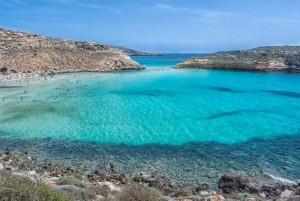
©Bigstock.com/dc975
You’ll find some of the most beautiful beaches in the world on Sicily. Some of them are tough to reach, but those somewhat remote, difficult-to-access spots are particularly worthwhile. One of them is the Spiaggi dei Conigli on an isle just a few metres outside the southwest coast of Lampedusa. No-one really knows where the name “Rabbit Island” comes from, but you certainly won’t find any fluffy bunnies here. The beach, however, is truly awesome. While the path across the stone steps will demand quite something from you, the clear turquoise water certainly is worth it.
Cathedral of Syracuse
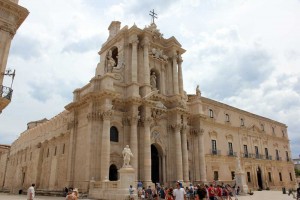
©ZAINOO Travel Guide
Ortygia, the historic city centre of Syracuse, had already been populated in the Bronze Age and is home to numerous architectural beauties. Today’s Santa Maria delle Colonne, the Cathedral of Syracuse, is located on the former site of a Greek Temple of Athena dating back to the 7th century BC with the more modern temple even reusing some parts of that very same ancient temple. Passing the masterful baroque front, you come across a mix of several epochs including an ancient rock baptistery and numerous medieval statues of saints.
Catania Cathedral
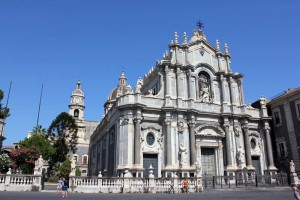
©ZAINOO Travel Guide
Unlike the Cathedral of Syracuse, the one in Catania is much younger. Sant’Agata was built on the Roman Achilles thermae, where Saint Agatha died the death of a martyr. Built in the late 11th century by the Normans, the imposing cathedral was reconstructed and converted several times over the course of the following centuries with the weighty baroque splendour only having been removed a few decades ago. You’ll come across various sarcophagi and reliquary caskets inside the cathedral containing the remains of members of the Aragonese royal house and those of Saint Agatha herself.
Valle dei Templi in Agrigento
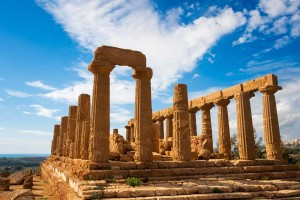
©Bigstock.com/afinocchiaro
The Greek roots of the city of Agrigento in Sicily are located on a high plateau slightly below today’s city core and are thus also called “Valley of the Temples” by the public. The archaeological sites declared UNESCO World Heritage Site in 1997 grant deep insights into ancient settlement history. Join a guided tour to the impressive ruins of temples, gardens, sanctuaries and necropolises, and cap off your visit by going onto Poggetto San Nicola with the archaeological museum and ruins of the administrative centre of the ancient town.
Villa Romana del Casale near Piazza Armerina
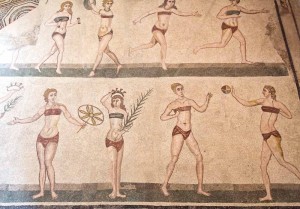
©Bigstock.com/lachris77
Just like the Greeks, the Romans were also quite active in Sicily. How active, you ask? The Villa Romana del Casale near the small town of Piazza Armerina provides deep insights into the luxurious lifestyle of erstwhile times. Probably built during the second half of the fourth century, you’ll come across well-preserved ruins of the former country house. The mosaics survived the centuries very well. They are now protected by a canopied construction modelled after the villa and absolutely need to be seen.
Noto’s historic city centre
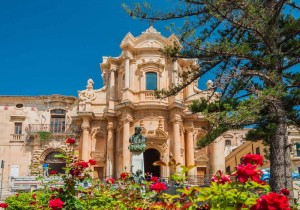
©Bigstock.com/Frog Dares
A devastating earthquake destroyed Noto Antica, predecessor to today’s Noto, in 1693. Only ten years later, an entirely new Sicilian baroque-style city arranged around a rectangular grid system was built. This ideal of the late baroque period with numerous magnificent buildings invites you to go on an unforgettable round tour. Countless churches with the tremendous cathedral as their highlight, fascinating palazzi and the museum combining modern art with ancient finds from the region let you dive deep into a unique architectural vision rightfully declared UNESCO World Heritage Site.
Erice
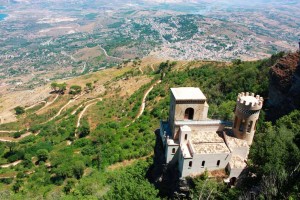
©Bigstock.com/OPOLJA
While Noto makes late-baroque dreams come true, Erice takes you back to pre-Christian days. The walls of the city located on a mountain and connected to the valley by cable car date back to Punic times. Erice was abandoned in Late Antiquity and initially occupied by the Arabs before being populated by the Normans, who added mighty towers to the ancient walls. Be enchanted by the stylistic plurality, which is probably captured best in the church. Built in 14th-century Gothic Chiaramonte style, the inside certainly displays much younger neo-Gothic design.
Cappella Palatina in Palermo
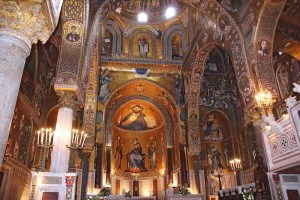
©Bigstock.com/smuki
Palermo’s Palazzo Reale located in the medieval city centre already is an imposing building as such. However, if you don’t have enough time at hand to tour the entire palace, you should at least visit the Cappella Palatina on the first floor. It combines the Byzantine Rite and the Roman Rite, both of which have different reading orders for its respective iconographies and clash in a fascinating manner in the chapel adorned with marble, wood and porphyry. Pictorial representations from the Old and the New Testament, figurines of angels, and fine mosaics are framed by massive marble pillars.
Teatro Greco in Taormina
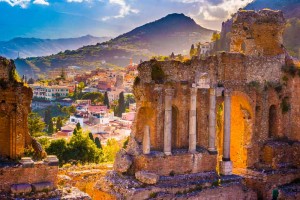
©Bigstock.com/Romas_ph
Despite its name, Sicily’s second-largest ancient theatre is a Roman construction dating back to the 2nd century BC and was built on a smaller Greek theatre. Originally a centre of drama, later years saw bloody bestial and gladiatorial combats take place here. Teatro Greco remains well-preserved to this day. Enjoy the amazing panoramic view of Mount Etna and the sea that will have your imagination run wild during the numerous modern events and concerts held in ancient ambiance. The next-door archaeological museum houses a marble pedestal referring to the ancient Olympic Games.
But that’s not all by a long shot! Sicily has far more to offer from its wide, almost endless coastal strips to fascinating ancient buildings and ruins. Find the best travel suggestions fo the largest Mediterranean island on ZAINOO. Have you already booked your holiday?